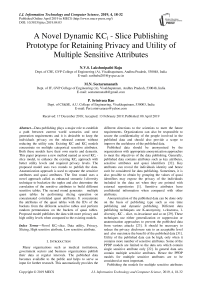A novel dynamic KCi - slice publishing prototype for retaining privacy and utility of multiple sensitive attributes
Автор: N.V.S. Lakshmipathi Raju, M.N. Seetaramanath, P. Srinivasa Rao
Журнал: International Journal of Information Technology and Computer Science @ijitcs
Статья в выпуске: 4 Vol. 11, 2019 года.
Бесплатный доступ
Data publishing plays a major role to establish a path between current world scenarios and next generation requirements and it is desirable to keep the individuals privacy on the released content without reducing the utility rate. Existing KC and KCi models concentrate on multiple categorical sensitive attributes. Both these models have their own merits and demerits. This paper proposes a new method named as novel KCi - slice model, to enhance the existing KCi approach with better utility levels and required privacy levels. The proposed model uses two rounds to publish the data. Anatomization approach is used to separate the sensitive attributes and quasi attributes. The first round uses a novel approach called as enhanced semantic l-diversity technique to bucketize the tuples and also determine the correlation of the sensitive attributes to build different sensitive tables. The second round generates multiple quasi tables by performing slicing operation on concatenated correlated quasi attributes. It concatenate the attributes of the quasi tables with the ID's of the buckets from the different sensitive tables and perform random permutations on the buckets of quasi tables. Proposed model publishes the data with more privacy and high utility levels when compared to the existing models.
Novel KCi-slice, Data utility, Privacy, Slicing, High sensitive attribute, Low sensitive attribute
Короткий адрес: https://sciup.org/15016349
IDR: 15016349 | DOI: 10.5815/ijitcs.2019.04.03
Текст научной статьи A novel dynamic KCi - slice publishing prototype for retaining privacy and utility of multiple sensitive attributes
Published Online April 2019 in MECS
Many organizations such as medical institutions, government sectors and business organizations publish their data at regular intervals. The published data becomes available to the public and helps to serve as input for further research. This automatically provides the different directions to the scientists to meet the future requirements. Organizations can also be responsible to secure the confidentiality of the people involved in the published data and should also provide a scope to improve the usefulness of the published data.
Published data should be anonymized by the organizations with appropriate anonymization approaches to meet the objectives of the data publishing. Generally, published data contains attributes such as key attributes, sensitive attributes and quasi identifiers [32]. Key attributes can reveal the individuals identity and hence can't be considered for data publishing. Sometimes, it is also possible to obtain by grouping the values of quasi identifiers may expose the privacy of the individuals included in the data set when they are pointed with external repositories [1]. Sensitive attributes have confidential information when compared with other attributes.
Anonymization of the published data can be done only on the basis of publishing type such as one time publishing and dynamic publishing. Different data publishing techniques are K-anonymity, t-closeness, l-diversity, KC – slice, m-invariance and so on [29]. These techniques use either generalization or suppression or anatomization approaches to prevent the published data from various attacks [23]. It should be necessary to reduce the privacy disclosure rate to an acceptable level and also maximize the benefit of the published data [31]. Utility of the published data can be high, only when it contains more number of sensitive attributes. Some of the PPDP models are limited to the data sets which contain single sensitive attribute only [22]. In general data sets contain multiple sensitive attributes. Hence the PPDP models for multiple sensitive attributes are to be considered at most important.
Publishing the models for multiple sensitive attributes is to be considered with extra care and attention. These models should preserve the confidentiality of the people included in the released content from different types of attacks including back ground knowledge attack, membership attack and various other attacks and also these models should exhibit more useful information. Existing PPDP models on multiple sensitive attributes do not satisfy the goals with respect to privacy and utility. The proposed novel KCi- slice model also considers multiple categorical sensitive attributes while publishing the data.
Privacy and utility of a sensitive attribute are inter dependent [13]. Dataset is published with high privacy means that it is not possible to expect high utility rate from it. From the published data, it should be necessary to acquire the required utility levels and privacy levels with respect to sensitiveness of the attributes. The proposed novel KC i - slice model moves in this path by acquiring the necessary utility levels and privacy levels on the sensitive attributes and chooses all the sensitive values of a sensitive attribute having equal priority. This model also considers attribute sensitiveness. Based on the sensitiveness of the sensitive attributes, this model considers the sensitive attributes as either high sensitive attributes or low sensitive attributes to acquire more privacy levels with good utility rates. High sensitive attribute is one which contains more number of high sensitive values with contrast to low sensitive attributes, which can be determined by a threshold level [7].
The remaining part of the paper is organized as follows. Section II explains related work, Section III describes the methodology of the work, Section IV reveals the results analysis, Section V explains the attacks against privacy protection and Section VI focuses on the conclusion with future extensions.
-
II. Related Work
In today's world, different models are available to publish the data of multiple sensitive attributes. Each model have their own strengths and weaknesses.
Liu et al [9] introduced an approach called as rating for publishing sensitive data and to maintain the correlations among the published data. This approach considers the sensitivity degree of the attributes while publishing the data and also introduces the algorithms to publish the tables. It implements each attribute in an independent manner, which can affect the relations among sensitive attributes.
Liu et al. [7] described a model for numerous sensitive attributes which discriminate the high sensitive attributes from low sensitive attributes using greedy approach and new k-anonymity technique. This model applies the greedy approach to sort the tuples of high sensitive attributes and break the associations among high sensitive values. It can secure the published content from different attacks and requires more execution time.
Yuki et al. [24] proposed an approach for anonymization and analysis of horizontally and vertically divided user profile databases with multiple sensitive attributes. This approach inserts the duplicate values into the original data to protect the data from various types of attacks while publishing. It also uses a separate method to reduce the influence of the noise generated from duplicate insertion and also shows the anonymization method when the participants were only two organizations. It was focused on the analysis of sensitive attributes, but it should necessary to concentrate on the analysis of both quasi attributes and sensitive attributes.
Ashoka et al. [26] described a model on enhanced utility in preserving privacy for multiple heterogeneous sensitive attributes using correlation and personal sensitivity flags. This model concentrated on both numerical and categorical sensitive attributes by also considering the personal sensitivity flags of the record owners. It can also find out the highly correlated sensitive attributes by using correlation. Anonymization operation can be done only on the tuples which require the privacy and publish the remaining tuples as it is to improve the utility rate of the published data. But this work is suitable only for one time publication and does not concentrated on multiple releases.
Maheshwarkar et al. [14] implemented an approach to secure the confidentiality of the published data for numerous sensitive attributes by adding an extra record to maintain diversity and anonymity of the equivalence classes based on the k-factor of the data base. This model can reduce the distortion without performing any tuple suppression. But the k-anonymity may be attacked by using backdrop awareness.
Han et al. [4] demonstrated an approach for multiple sensitive attributes micro data termed as SLOMS. This method uses slicing to split the micro data into different tables and l-diversity algorithm is used to group the tuples. SLOMS approach anonymizes the quasi attributes by using K-anonymity algorithm and MSB-KACA technique is used to anonymize the micro data with numerous sensitive attributes. This model generates large suppression and it takes extra execution time.
Shyamala susan et al. [20] implemented a new model for numerous sensitive attributes using anatomization and slicing. This approach uses vertical partitioning to break the relations between the different sensitive attributes and generate the various sensitive tables by an advanced clustering algorithm. It uses MFA algorithm to bucketize the tuples. This model reduces the suppression rate by using anatomization algorithm and limits the high dimensionality by using slicing algorithm. It safeguards the data against different attacks. This model generates the quasi identifier table and sensitive tables by using slicing technique in an individual manner.
Abou_el_ela abdo hussain et al. [27] introduced a model for multiple published tables privacy preserving data mining. This model introduces techniques to secure the individual privacy when the organization releases more than one table. This paper publishes the two tables by using the concepts of (a,k)-anonymity with lossy join and anatomy technique. It publishes the separate tables for sensitive values and quasi values. But this work considers a single sensitive attribute in each published table. Aldeen et al. [30] also used (a,k) anonymity technique for their experimental investigation to ensure privacy among published tables.
Usha et al. [21] implemented a model by considering the sensitiveness of the attributes using k-anonymity and non-homogeneous anonymization for numerous sensitive attributes. Generalization can be performed on the basis of high sensitive attribute. The anonymization of the quasi attributes can be decided only on the basis of cluster sensitiveness. But this model was not implemented on original data sets. Also, it can be cracked by backdrop awareness.
Yifan ye et al. [28] described an anonymization approach by including both anatomy and permutation for securing the privacy in micro data with multiple sensitive attributes. This paper anonymizes the data by using the algorithms called as naive multi sensitive bucketization permutation and closest distance multi sensitive bucketization permutation. This approach is suitable only for one time release and it was not concentrated on multiple releases.
Qinghai Liu et al. [12] demonstrated an approach by using the techniques of clustering and multi-sensitive bucketization for multiple numerical sensitive attributes named as MNSACM. This method considers only two numerical sensitive attributes and does not explain the methodology for more than two numerical sensitive attributes. This method can be applicable to numerical sensitive attributes and which is not suitable for categorical attributes. It is limited to onetime publication only.
Hassan et al [5] described a model to preserve the confidentiality on multiple independent data publishing. This model concentrates on the new direction and introduces a composition attack. It can also provide a solution called as cell generalization to improve the utility rate and individual’s confidentiality of the released content. This method combines the different published data sets by maintaining the l-diversity requirements and it was implemented on single sensitive attribute only.
Anjum et al. [1] introduced a model for numerous sensitive attributes using (p,k) - Angelization technique to protect the data from different types of attacks. This model publishes a sensitive table for all the sensitive attributes and a quasi table for all the quasi attributes. It generalizes the quasi values of a quasi table to protect the data from demographic attacks and also increases the privacy levels and utility levels of the published data. It is confined to the case that only a single tuple of a person shou ld be presented in the data.
Ram Prasad Reddy et al [19] demonstrated a new concept on personalized privacy model for numerous sensitive attributes. This approach uses deterministic anonymization on quasi attributes, generalization on categorical sensitive attributes and fuzzy approach on numerical sensitive attributes. Slicing technique is used to partition the dataset into different slices. This method considers only the static data and not assume that each categorical group should have only one occurrence of a value and duplicate value can be represented by higher level value.
Onashoga et al. [18] implemented a model using the concepts of LKC privacy technique and slicing named as KC - slice. LKC model generalizes traditional privacy models [16]. KC - slice model finally releases a quasi table and sensitive table. It does not prioritize the sensitiveness of the attributes and concentrates on only one sensitive value from each sensitive attribute. Hence, there may be a chance to detect the suppressed sensitive values from the sensitive buckets. This method chooses constant privacy level on all the sensitive attributes and does not use any technique to bucketize the tuples and it may lead to similarity attacks.
Lakshmipathi Raju N.V.S. et al. [6] implemented a model for multiple sensitive attributes to overcome the pitfalls of the KC - slice model named as KCi - slice to preserve the individuals confidentiality on the released content by considering the attributes sensitiveness. This approach chooses different thresholds to the various sensitive attributes based on their sensitiveness and generates a quasi table and various sensitive tables. This model reduces the similarity attacks by using a semantic l-diversity technique for bucketization of the tuples and produce the acceptable results with respect to privacy and utility. But, the semantic l-diversity technique does not concentrate on the sensitivity levels of the sensitive values and this may affect the individual’s privacy on the published content.
-
III. Methodology of the Models
-
A. Previous Models (KC–Slice & KCi – Slice)
These models choose multiple sensitive attributes while publishing the data. KC – slice model gives priority to only one sensitive value of each sensitive attribute and does not concentrate on the remaining sensitive values of a sensitive attribute even if it contains other high sensitive values. This model does not consider attribute sensitiveness and gives equal priority to all the sensitive attributes. No proper technique is used for the bucketization of the tuples and also produces a separate table to publish sensitive attributes. This approach considers a same level of threshold to each sensitive attribute. This method suppresses a single value for each sensitive attribute which facilitates a scope to recognize a suppressed sensitive value from the sensitive bucket [18].
KCi – slice model considers the attribute sensitiveness and also gives equal priority to all the values of a sensitive attribute. This approach uses semantic l-diversity algorithm for grouping the tuples and considers different threshold levels to various sensitive attributes based on their sensitiveness. Semantic l-diversity algorithm considers the semantic levels of the values while forming the groups, but it does not consider the sensitivity level of the sensitive values. Consider a bucket having three disease values like HIV, liver cancer and heart attack. These three values can belong to three distinct semantic levels, which satisfies the rule of the semantic l-diversity algorithm [25]. But these three values come under high sensitive diseases. Assume a victim resides in the group by considering the background knowledge. Even though one need not find the disease of the victim, it is possible to recognize that person is suffering from high sensitive disease. It may lead to various sensitivity attacks and high suppression ratio.
The major drawback of the semantic l-diversity technique is its un-ability to restrict the sensitivity attacks. Finally, this approach produces the results in the form of a single quasi table and multiple sensitive tables [6]. Due to this there may be a possibility to associate the sensitive attributes with quasi attributes.
-
B. Proposed Novel KCi – Slice Model
The proposed model uses a novel methodology to publish the data when compared to the previous models. Initially, anatomization approach is used to separate the sensitive attributes and quasi attributes. Until now all the existing models on multiple sensitive attributes concentrated on only similarity attacks and do not concentrate on sensitivity attacks. To overcome this problem, proposed model designs a new technique named as enhanced semantic l-diversity technique to group the tuples in order to effectively eliminate both the similarity attacks and sensitivity attacks. The methodology of the enhanced semantic l-diversity technique is different from semantic l-diversity technique which is used in previous KC i – slice model. Some of the existing models on multiple sensitive attributes publish data in the form of multiple sensitive tables along with a single quasi table [6]. But the proposed model publishes the data in the form of multiple sensitive tables and multiple quasi tables by using slicing approach in order to completely minimize the all types of linkage attacks. That's why this model is named as novel KC i – slice model.
Let us discuss the proposed novel KC i – slice model in an elaborated manner. The proposed novel KC i – slice model can overcome the pitfalls of the existing models and also produces expected outcomes in terms of utility and privacy. Table 1 shows a slice of the original data. This approach initially splits the entire data set into quasi identifier table and sensitive table by using anatomization approach. Table 2 specifies the quasi attribute table having attribute like hours, lifetime, sex, income, zip and country. Table 3 is the sensitive table having the sensitive attributes like education, disease, relationship and occupation.
The proposed model uses two slots to finish the publication process. As per the first algorithm, initially it can find out the bucket size by all the records on the data set with all distinct sensitive values of each sensitive attribute and also considers each sensitive attribute have a separate threshold level as per the attribute sensitiveness. The proposed approach can also discriminate the sensitive attributes as either high or low based on the number of high sensitive values of each sensitive attribute [7]. It chooses disease attribute and occupation attribute as high sensitive when contrast to the remaining two sensitive attributes.
This paper also introduces a new enhanced semantic l-diversity technique to formulate the tuple groups. The methodology of this technique is included in algorithm 1. This approach considers both the semantic levels and sensitivity levels of the high threshold sensitive attribute values. In this approach, initially it categorizes the high threshold sensitive attribute values into either high or low sensitive values based on their sensitiveness for each semantic level. It also considers the ratio of total high sensitive values and total low sensitive values of all the semantic levels of high threshold sensitive attribute while formulating the groups. This method assigns the tuples in to each bucket from both high sensitive category and low sensitive category of all the semantic levels thereby forming the effective groups and also considers the overall ratio of high sensitive values and low sensitive values in order to evenly distribute both high sensitive values and low sensitive values into each group. When a tuple is placed in to a bucket, then it reduces the tuple count from that semantic category and also reduces the tuple count from the overall ratio. By maintaining all these things, it is possible to see both the high sensitive values and low sensitive values into each bucket there by reducing the sensitivity attacks. By considering the semantic levels and sensitivity levels of the sensitive values it can effectively limit the sensitivity attacks and similarity attacks thereby reducing the suppression ratio and increases utility rate of the released content [11].
Let us demonstrate the example specified in the paper, assume that the threshold levels of the attributes are occupation and disease is 2 and education and relationship is 3 accordingly. In the proposed model bucketization is done based on the disease sensitive attribute. The sensitive attribute education have 4 values of the doctorate, obviously one value is to be reduced from doctorate is depicted in Table 4, because the maximum threshold of the education is considered as only 3. Table 3 specifies that disease attribute have 3 values of tumor and 3 values of stomach cancer. This model can automatically suppress one value from both tumor and stomach cancer specified in Table 5. There is no need to suppress any value of the relationship attribute, because the counts of all the values are in the specified range of relationship. As per Table 4, one value of the exec-managerial in occupation sensitive attribute is to be suppressed. This model also generates different sensitive tables based on their correlation among sensitive attributes to protect the data against various attacks. Highly correlated sensitive attributes of educationoccupation and disease-relationship with their corresponding counts are depicted in Table 4 and Table 5.
As per the second algorithm, each sensitive bucket should have ID. Table 4 and 5 depicts the sensitive bucket IDs. This model also concatenates the correlated quasi attributes based on the correlation among quasi attributes. Table 6 presents the concatenated quasi attributes. Novel KCi – slice model also performs the vertical partition on Table 6 to generate the multiple quasi tables and secure the data from different attacks. The vertical partitioning can be done on the basis of the total sensitive attributes residing on the original data. This method does not anonymizes the quasi values to produce better utility rates.
The proposed model also concatenates the IDs of sensitive buckets with the correlated quasi attributes. As per the example, it concatenates the IDs of Table 4 with one slice of Table 6 resulting in Table 7 and also concatenate the IDs of Table 5 with remaining slice of the Table 6 resulted in Table 8. Finally, this model performs random alterations on the buckets of Table 7 and Table 8 to produce the final tables Table 9 and Table 10. This model finally publishes sensitive tables Table 4 and Table 5 and quasi tables Table 9 and Table 10.
Table 1 . Slice of the original data set
|
Hours |
Lifetime |
Sex |
Income |
Pin code |
Native |
Education |
Disease |
Relationship |
Occupation |
|
24 |
40 |
F |
34500 |
55322 |
India |
Doctorate |
Tumor |
Husband |
Other-service |
|
15 |
28 |
M |
172000 |
22190 |
Mexico |
Masters |
Stomach cancer |
Not-in-family |
Dam-clerical |
|
55 |
27 |
F |
54000 |
25174 |
England |
Doctorate |
Malaria |
Wife |
Craft-repair |
|
37 |
22 |
F |
64000 |
55322 |
India |
Bachelors |
Motion |
Not-in-family |
Transport-moving |
|
19 |
39 |
M |
81500 |
22190 |
Mexico |
11th |
Stomach cancer |
Own-child |
Exec-managerial |
|
35 |
33 |
F |
82000 |
22190 |
Mexico |
Doctorate |
Tumor |
Wife |
Exec-managerial |
|
40 |
24 |
F |
740000 |
25174 |
England |
Bachelors |
Heart pain |
Wife |
Craft-repair |
|
27 |
37 |
F |
133500 |
55322 |
India |
Doctorate |
Stomach cancer |
Not-in-family |
Craft-repair |
|
26 |
46 |
M |
61000 |
22190 |
Mexico |
Hs-grad |
Tumor |
Husband |
Exec-managerial |
|
34 |
22 |
M |
32500 |
55322 |
India |
Masters |
Malaria |
Own-child |
Exec-managerial |
Table 2. Quasi Table
|
Hours |
Lifetime |
Sex |
Income |
Pin code |
Native |
|
24 |
40 |
F |
34500 |
55322 |
India |
|
15 |
28 |
M |
172000 |
22190 |
Mexico |
|
55 |
27 |
F |
54000 |
25174 |
England |
|
37 |
22 |
F |
64000 |
55322 |
India |
|
19 |
39 |
M |
81500 |
22190 |
Mexico |
|
35 |
33 |
F |
82000 |
22190 |
Mexico |
|
40 |
24 |
F |
740000 |
25174 |
England |
|
27 |
37 |
F |
133500 |
55322 |
India |
|
26 |
46 |
M |
61000 |
22190 |
Mexico |
|
34 |
22 |
M |
32500 |
55322 |
India |
Table 3 . Sensitive Table
|
Education |
Disease |
Relationship |
Occupation |
|
Doctorate |
Tumor |
Husband |
Other-service |
|
Masters |
Stomach cancer |
Not-in-family |
Dam-clerical |
|
Doctorate |
Malaria |
Wife |
Craft-repair |
|
Bachelors |
Motion |
Not-in-family |
Transport-moving |
|
11th |
Stomach cancer |
Own-child |
Exec-managerial |
|
Doctorate |
Tumor |
Wife |
Exec-managerial |
|
Bachelors |
Heart pain |
Wife |
Craft-repair |
|
Doctorate |
Stomach cancer |
Not-in-family |
Craft-repair |
|
Hs-grad |
Tumor |
Husband |
Exec-managerial |
|
Masters |
Malaria |
Own-child |
Exec-managerial |
Table 4. Grouping of SA's at explicit threshold level for education and occupation
|
ID |
Sensitive attributes |
|
01 |
#####(1), Doctorate(3),Bachelors(2), 11th(1), Masters(2),Hs-grad(1) |
|
02 |
#####(1), Exec-managerial(3),Other-service(1), Transport-moving(1) ,Dam-clerical(1), Craft-repair(3) |
Table 5. Grouping of SA’s at explicit threshold level for disease and relationship
|
ID |
Sensitive attributes |
|
11 |
#####(2),Tumor(2), Malaria(2), Heart Pain(1), stomach Cancer(2),Motion(1) |
|
12 |
Wife(3), Own-Child(2),Not-in-family(3), Husband(2) |
Utility of Multiple Sensitive Attributes
Table 6. Concatenated quasi attributes based on their correlation
|
Hours/Income |
Lifetime |
Sex |
Pin code/Native |
|
24,34500 |
40 |
F |
55322,India |
|
15,172000 |
28 |
M |
22190, Mexico |
|
55,54000 |
27 |
F |
25174, England |
|
37,64000 |
22 |
F |
55322, India |
|
19,81500 |
39 |
M |
22190, Mexico |
|
35,82000 |
33 |
F |
22190, Mexico |
|
40,740000 |
24 |
F |
25174, England |
|
27,133500 |
37 |
F |
55322, India |
|
26,61000 |
46 |
M |
22190. Mexico |
|
34,32500 |
22 |
M |
55322, India |
Table 7. Concatenation of correlated Quasi attributes with IDs of SAs after vertical partitioning of QID
|
Hours/Income |
Lifetime |
|
24,34500,01 |
40,02 |
|
15,172000,01 |
28,02 |
|
55,54000,01 |
27,02 |
|
37,64000,01 |
22,02 |
|
19,81500,01 |
39,02 |
|
35,82000,01 |
33,02 |
|
40,740000,01 |
24,02 |
|
27,133500,01 |
37,02 |
|
26,61000,01 |
46,02 |
|
34,32500,01 |
22,02 |
Table 8. Concatenation of correlated Quasi attributes with IDs of SAs after vertical partitioning of QID
|
Sex |
Pin code/Native |
|
F,11 |
55322,India,12 |
|
M,11 |
22190, Mexico,12 |
|
F,11 |
25174, England,12 |
|
F,11 |
55322, India,12 |
|
M,11 |
22190, Mexico,12 |
|
F,11 |
22190, Mexico,12 |
|
F,11 |
25174, England,12 |
|
F,11 |
55322, India,12 |
|
M,11 |
22190. Mexico,12 |
|
M,11 |
55322, India,12 |
Table 9. Permutated Quasi attributes and IDs of SAs
|
Hours/Income |
Lifetime |
|
15,172000,01 |
28,02 |
|
24,34500,01 |
40,02 |
|
35,82000,01 |
33,02 |
|
27,133500,01 |
37,02 |
|
34,32500,01 |
22,02 |
|
19,81500,01 |
39,02 |
|
37,64000,01 |
22,02 |
|
40,740000,01 |
24,02 |
|
26,61000,01 |
46,02 |
|
55,54000,01 |
27,02 |
Table 10. Permutated Quasi attributes and IDs of SAs
|
Sex |
Pin code/Native |
|
F,11 |
55322,India,12 |
|
F,11 |
55322, India,12 |
|
M,11 |
22190, Mexico,12 |
|
F,11 |
25174, England,12 |
|
F,11 |
22190, Mexico,12 |
|
M,11 |
22190. Mexico,12 |
|
M,11 |
22190, Mexico,12 |
|
F,11 |
25174, England,12 |
|
F,11 |
55322, India,12 |
|
M,11 |
55322, India,12 |
Threshold | 5 | 10 | 15 | 20 | 25 | 30 | 35 | 40 |
Education | 0.372 | 0.193 | 0.077 | 0.032 | 0.0006 | 0 | 0 | 0 |
Disease | 0.024 | 0 | 0 | 0 | 0 | 0 | 0 | 0 |
Relationship | 0.32 | 0.196 | 0.12 | 0.065 | 0.037 | 0.01 | 0 | 0 |
Occupation | 0.274 | 0.03 | 0.001 | 0 | 0 | 0 | 0 | 0 |
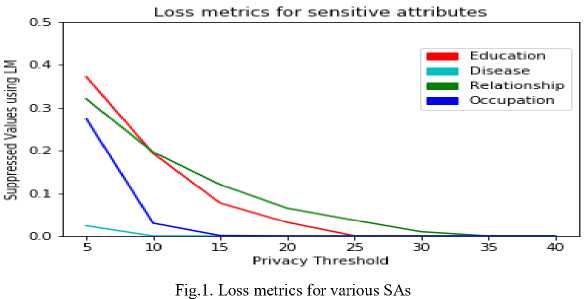
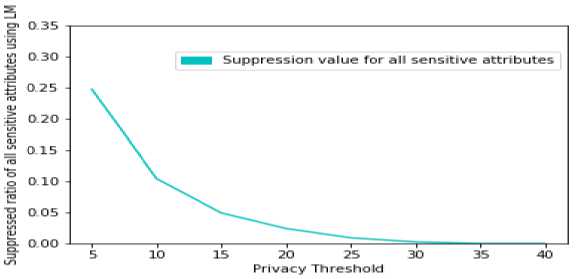
Fig.2. Overall LM for all Sas
B. Minimal Distortion
Distortion can be measured by weighted hierarchical distance (WHD), which is used to measure the anonymization at various levels of abstractions. Higher levels produce more amount of distortion with respect to lower levels [10].
WHD ( x, y) =
xW
■^ i=y+1 i, l-1
tW
^^ l=2 i • i-1
As per formula (2) hierarchy height of a specific domain as t, this ranges from most general level to most specific level. It ranges from 1,2,3,...,t-1,t. Weight between two consecutive domains can be denoted by 1. The value of value of i ranges from 2 to h.
In uniform weight, the value of
W ,.-1 = 1 (3)
For height weight,
W,, , = —-, where p > 1 (4) '•'-1 (i -1)e
Formula (3) specifies the weight between i and i-1 domains in the case of uniform weight and formula (4) specifies weight between the two consecutive domains in the case of height weight respectively.
Distortion(t, t’) = ^™ WHD(level(a,), level(a )) (5)
Formula (5) is used to measure the distortion between an ordinary tuple and an anonymized tuple. Formula (3) and Formula (4) are used to uniform weight and height weight respectively.
Distortion (D, D') = ^^Distortion (t3, t) (6)
Formula (6) gives the distortion among tables. tj specifies normal table and tj’specifies anonymized table.
Fig. 3 shows that the distortion rates produced by this model are less at initial threshold levels and 0 at all other threshold levels in case of high sensitive attributes. Distortion rates are also decreasing while increasing the threshold in the case of low sensitive attributes.
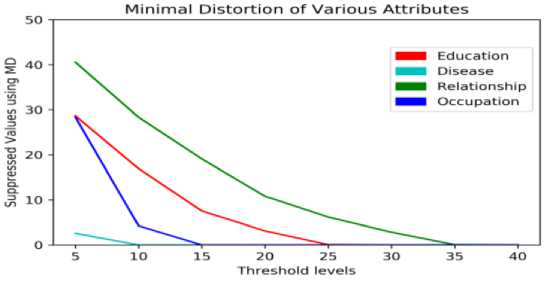
Fig.3. Minimal distortion of attributes at various levels.
C. Suppressed and Unsuppressed Values
Fig. 4 and Fig. 5 specify the relation between suppressed values with total values and suppressed values with unsuppressed values respectively. Fig. 4 indicates that proposed novel KCi – slice model obtains 28.39% suppression rate when compared to 40% in KCi – slice model at privacy level 5. Education sensitive attribute acquires 28.68% suppression rate in the proposed model when compared to 38% suppression rate in KCi – slice model. Fig. 5 shows the relation between suppressed and unsuppressed values is also reducing by increasing the threshold for all sensitive attributes.

Percentage of Suppressed Values to unsuppressed values for each attribute

Fig.5. Percentage ratio of suppressed with unsuppressed value
D. Utility Gain
Published data utility gain can be measured by the trade-off metrics, which can find out the privacy loss and information gain for each generalization or suppression activity [3]. It can be represented by
IGPL (c ) = IG (c)
PL (c) +1
As per formula (7) IG(c) specifies the information gain, PL(c) specifies the privacy loss of either generalization or suppression operation. This metric is useful to determine important relations among the published data, which can be dependent on the type of the anonymization operation used on the published data [8]. The unsuppressed and suppressed values of education sensitive attribute are depicted in Table 12 and Table 13. As per Fig. 6 and Fig. 7, the suppression rate can be minimized by increasing the privacy level. No need to consider high thresholds to the education attribute, because proposed model considered as a low sensitive attribute. This specifies that it is possible to obtain the maximum utility rate by applying the required threshold level.
The utility gain of heart pain and glaucoma of disease attribute are depicted in Table 14 and Table 15. According to the Fig. 8 and Fig. 9 specifies that suppression rate is almost negligible at even high thresholds and 0 for remaining all thresholds. This concludes that disease sensitive attribute acquires the highest utility rate at initial thresholds only.
The suppressed values of husband and own-child of relationship attribute are depicted in Table 16 and Table 17. From Fig. 10 and Fig. 11 describe that the number of unsuppressed values are increased by increasing the threshold.
Table 18 and Table 19 highlight the other-service and exec-managerial values of occupation sensitive attribute. As per Fig. 12 and Fig. 13 the suppression rate is less at high thresholds and 0 at other thresholds. As per the results, novel KCi – slice model yields good results when compared to the previous KC - slice and KCi – slice models.
Table 12. Hs-grad - Suppressed and Unsuppressed values Total : 10,501
Thresholds | 5 | 10 | 15 | 20 | 25 | 30 | 35 | 40 |
Suppressed | 5425 | 4216 | 2452 | 1015 | 25 | 0 | 0 | 0 |
Un-suppressed | 5076 | 6285 | 8049 | 9486 | 10476 | 10501 | 10501 | 10501 |
Table 13. Bachelors - Suppressed and Unsuppressed values Total : 5355
Thresholds | 5 | 10 | 15 | 20 | 25 | 30 | 35 | 40 |
Suppressed | 1310 | 65 | 0 | 0 | 0 | 0 | 0 | 0 |
Un-suppressed | 4045 | 5290 | 5355 | 5355 | 5355 | 5355 | 5355 | 5355 |
Table 14. Heart pain - Suppressed and Unsuppressed values Total: 1843
Thresholds | 5 | 10 | 15 | 20 | 25 | 30 | 35 | 40 |
Suppressed | 62 | 0 | 0 | 0 | 0 | 0 | 0 | 0 |
Un-suppressed | 1781 | 1843 | 1843 | 1843 | 1843 | 1843 | 1843 | 1843 |
Table 15. Glaucoma - Suppressed and Unsuppressed values Total: 1853
Thresholds | 5 | 10 | 15 | 20 | 25 | 30 | 35 | 40 |
Suppressed | 45 | 0 | 0 | 0 | 0 | 0 | 0 | 0 |
Un-suppressed | 1808 | 1853 | 1853 | 1853 | 1853 | 1853 | 1853 | 1853 |
Table 16. Husband - Suppressed and Unsuppressed values Total: 13193
Thresholds | 5 | 10 | 15 | 20 | 25 | 30 | 35 | 40 |
Suppressed | 8452 | 7115 | 5112 | 3521 | 2012 | 925 | 21 | 0 |
Un-suppressed | 4741 | 6078 | 8081 | 9672 | 11181 | 12268 | 13172 | 13193 |
Table 17. Own-child - Suppressed and Unsuppressed values Total: 5068
Thresholds | 5 | 10 | 15 | 20 | 25 | 30 | 35 | 40 |
suppressed | 1102 | 25 | 0 | 0 | 0 | 0 | 0 | 0 |
un-suppressed | 3966 | 5043 | 5068 | 5068 | 5068 | 5068 | 5068 | 5068 |
b
1750 ■
1500 -
1250 ■
1000 -
750 ■
500 -
250 -
0 -1—t— 5
Utility gain for Heart pain in Disease
^e Suppressed Values
^e Unsuppressed Values
Threshold Levels
Fig.8. Utility gain of "heart pain"
Utility gain for Glaucoma in Disease _ 2000 л-----------—----------------------------
E _---
3 1750 - _— — .
Suppressed Values
0 ^qq . ^H Unsuppressed Values
$ 1250 -
•5 1000 -
I750 -
E v500 -
"5250 -
E u 0 J—i~~ i----------1-----------1----------1-----------1----------1r
5 10 15 20 25 30 3540
Threshold Levels
Fig.9. Utility gain of "glaucoma"
Cumulative amount of Relationship (Husband)
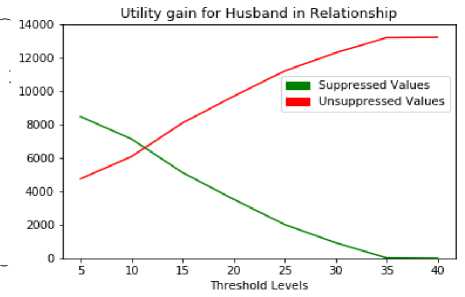
Fig. 10. Utility gain of "husband"
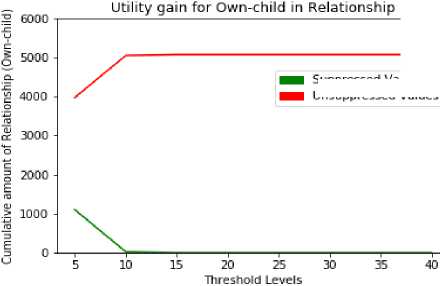
Fig. 11. Utility gain of "own-child"
Suppressed Values
Unsuppressed Values
Table 18. Other-service - Suppressed and Unsuppressed values Total: 5138
Thresholds | 5 | 10 | 15 | 20 | 25 | 30 | 35 | 40 |
Suppressed | 2235 | 975 | 80 | 0 | 0 | 0 | 0 | 0 |
Un-suppressed | 2903 | 4163 | 5058 | 5138 | 5138 | 5138 | 5138 | 5138 |
Table 19. Exec -managerial - Suppressed and Unsuppressed values Total: 4066
Thresholds | 5 | 10 | 15 | 20 | 25 | 30 | 35 | 40 |
Suppressed | 1511 | 95 | 0 | 0 | 0 | 0 | 0 | 0 |
Un-suppressed | 2555 | 3971 | 4066 | 4066 | 4066 | 4066 | 4066 | 4066 |
Suppressed Values
Jnsuppressed Values
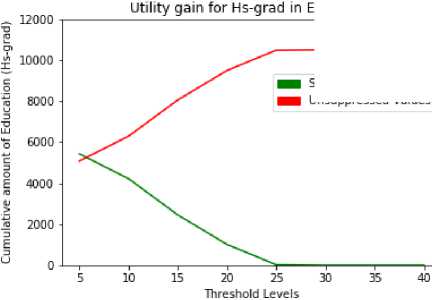
Fig.6. Utility gain of "hs-grad"
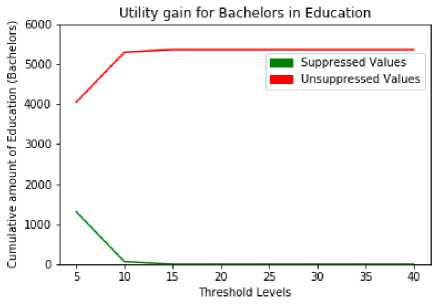
Fig.7. Utility gain of "bachelors"

Fig.13. Utility gain of "exec-managerial"
Fig.12. Utility gain of "other-service"
E. Comparison among Novel KCi-Slice Model with Other Models
The following section describes the effectiveness of the novel KCi model when compared with the KC-slice and KCi models. Fig. 14, Fig. 15 and Fig. 16 show the evaluation of different models for various sensitive values. Table 20 shows the comparison of all the three models for not-in-family of relationship at different thresholds. From Fig. 14, when contrast to other two models the novel KCi model generates less number of suppressed sensitive values at all thresholds. Table 21 shows that utility level of the novel KCi -slice model is high on all threshold levels against remaining two models.
Table 22 shows the suppressed values of some-college in education attribute. As per Fig. 15, novel KCi -slice model have more number of unsuppressed values, contrast to other two models. The proposed model also produces more amounts of utility levels than the remaining two models for some-college value is depicted in Table 23. Novel KCi -slice model acquires more than 16% excess utility rate against KCi -slice model and 38% extra utility rate against KC - slice model at threshold 5. The proposed model obtains excess utility levels at all thresholds when compared to the other models.
The suppressed values of exec-managerial at different threshold levels are shown in Table 24. As per Fig. 16, the rate of suppression is less at different thresholds in novel KCi -slice model with respect to the existing two models. Table 25 shows that novel KCi -slice model obtains more than 15% excess utility rate against KCi -slice model and 22% excess utility rate against KC - slice model at privacy level 5. Novel KCi -slice approach acquires excess utility rates for exec-managerial value of occupation at different threshold levels.
Table 20. Number of values suppressed for "not-in-family"
Thresholds | 5 | 10 | 15 | 20 | 25 | 30 | 35 | 40 |
Novel KCi-slice | 3641 | 2090 | 1105 | 0 | 0 | 0 | 0 | 0 |
KCi-slice | 4741 | 3121 | 1501 | 163 | 0 | 0 | 0 | 0 |
KC-slice | 6361 | 4741 | 3121 | 1501 | 179 | 0 | 0 | 0 |
Table 21. Utility levels for "not-in-family"
Thresholds | 5 | 10 | 15 | 20 | 25 | 30 | 35 | 40 |
Novel KCi-slice | 56.15% | 74.83% | 86.69% | 100% | 100% | 100% | 100% | 100% |
KCi-slice | 42.9% | 62.42% | 81.92% | 98% | 100% | 100% | 100% | 100% |
KC-slice | 23.4% | 42.2% | 61.46% | 80.73% | 97.84% | 100% | 100% | 100% |
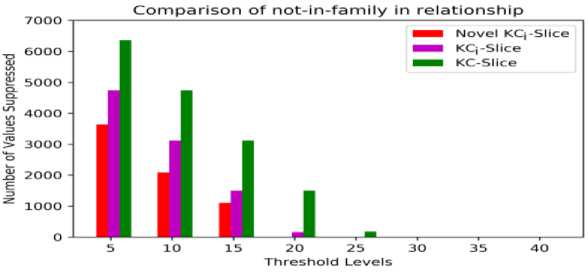
Fig.14. Comparison among various models for "not-in-family"
A Novel Dynamic KCi - Slice Publishing Prototype for Retaining Privacy and
Utility of Multiple Sensitive Attributes
Table 22. Number of values suppressed for "some-college"
Thresholds | 5 | 10 | 15 | 20 | 25 | 30 | 35 | 40 |
Novel KCi-slice | 2605 | 1232 | 0 | 0 | 0 | 0 | 0 | 0 |
KCi-slice | 3727 | 2107 | 568 | 539 | 5 | 0 | 0 | 0 |
KC-slice | 5347 | 3727 | 2201 | 568 | 45 | 0 | 0 | 0 |
Table 23. Utility levels for "some-college"
Thresholds | 5 | 10 | 15 | 20 | 25 | 30 | 35 | 40 |
Novel KCi-slice | 64.27% | 83.10% | 100% | 100% | 100% | 100% | 100% | 100% |
KCi-slice | 48.88% | 71.1% | 92.2% | 92.6% | 99.93% | 100% | 100% | 100% |
KC-slice | 26.66% | 48.88% | 69.81% | 92.2% | 99.89% | 100% | 100% | 100% |
Table 24. Number of values suppressed for "exec-managerial"
Thresholds | 5 | 10 | 15 | 20 | 25 | 30 | 35 | 40 |
Novel KCi-slice | 1511 | 95 | 0 | 0 | 0 | 0 | 0 | 0 |
KCi-slice | 2122 | 530 | 1 | 0 | 0 | 0 | 0 | 0 |
KC-slice | 2400 | 600 | 15 | 0 | 0 | 0 | 0 | 0 |
Table 25. Utility levels for "exec-managerial"
Thresholds | 5 | 10 | 15 | 20 | 25 | 30 | 35 | 40 |
Novel KCi-slice | 62.83% | 97.66% | 100% | 100% | 100% | 100% | 100% | 100% |
KCi-slice | 47.81% | 86.96% | 99.97% | 100% | 100% | 100% | 100% | 100% |
KC-slice | 40.97% | 85.24% | 99.63% | 100% | 100% | 100% | 100% | 100% |
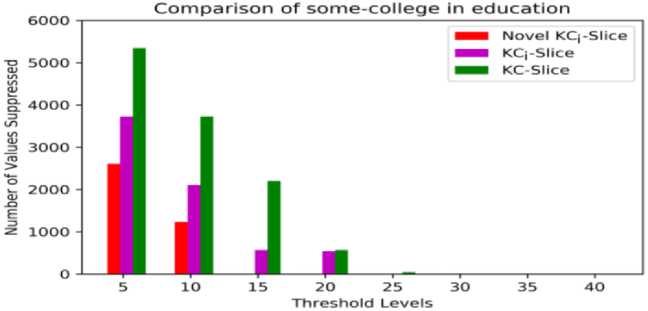
Fig.15. Comparison among various models for "some-college"
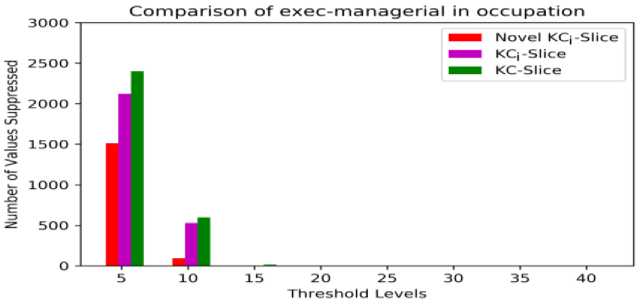
Fig.16. Comparison among various models for "exec-managerial
F. Working Environment And Data Set
Novel KCi - slice model was executed on windows 8
environment of 1.6 -GHz Pentium processor with 16 GB RAM. Python and MYSQL were used to implement this model. UCI machine learning repository published a data set called as adult data set and it was used for the experimental investigation [17].
V. Protection Against Various Attacks
The novel KCi - slice model produces the results in the form of multiple tables to protect the data against all types of linkage attacks. This model introduces a new enhanced semantic l-diversity approach to safeguard the data against the similarity attacks and sensitivity attacks. It publishes multiple sensitive tables and multiple quasi tables to protect the data against table linkage attacks. This model uses different thresholds on different attributes to safeguard the data against skewness attack and homogeneity attack. Due to the size of the bucket, it protects the data against correspondence attack, minimalist attack and backdrop knowledge attack.
VI. Conclusions and Future Extensions
Novel KCi - slice model chooses different threshold levels to each sensitive attribute according to the attribute sensitiveness and also all the sensitive values of an attribute are equally prioritized. To acquire the required utility levels and privacy levels, this paper also introduces a new concept called as enhanced semantic l-diversity algorithm for horizontal partitioning the tuples which considers both the sensitivity levels and semantic levels of the values of an attribute.
The proposed model categorizes the sensitive attribute as either high or low sensitive attributes based on the number of high sensitive values resides in a sensitive attribute. Novel KCi - slice model assigns variable thresholds to the different sensitive attributes with respect to their sensitiveness. It generates multiple sensitive tables for sensitive attributes and multiple quasi tables for quasi attributes based on their correlation to prevent from various types of attacks. Novel KCi - slice model acquires the excellent results with respect to privacy and utility when contrast to the other two models. This model can reduce all types of similarity attacks.
This work can also be extended in the other ways by considering categorical sensitive attributes along with numerical sensitive attributes. There is also necessary to design an algorithm to discriminate the high sensitive values and low sensitive values. This model also to be extended to the distributed data sets using horizontal partitioning and vertical partitioning approaches.
Список литературы A novel dynamic KCi - slice publishing prototype for retaining privacy and utility of multiple sensitive attributes
- Anjum A, Ahmed Naveed, Malik S.U, Zubair S, Shahzad B, "An efficient approach for publishing microdata for multiple sensitive attributes", The Journal of Supercomputing, pp. 1- 29, 2018.
- Fung B. C, Wang K, Fu A. W. C, Philip S. Y, "Introduction to Privacy - Preserving Data Publishing: Concepts and techniques", Chapman and Hall/CRC Press, 2010.
- Fung B. C. M, Wang K., Chen R, Yu P. S, "Privacy-preserving data publishing: A survey of recent developments", ACM Computing Surveys, 42(4), article 14, 2010.
- Han J, Luo F, Lu J, Peng H, "SLOMS: A Privacy Preserving Data Publishing Method for Multiple Sensitive Attributes Micro data", Journal of Software 8(12), pp. 3096-3104, 2013.
- Hasan A. S. M, Jiang Q, Chen H, Wang S, "A New Approach to Privacy-Preserving Multiple Independent Data Publishing", Applied Sciences, 8, 783, pp. 1-22, 2018.
- Lakshmipathi Raju N.V.S, Seetaramanath M.N, Srinivasa Rao P,(in press) "An enhanced dynamic KC-Slice model for privacy preserving data publishing with multiple sensitive attributes by inducing sensitivity", Journal of King Saud University-Computer and Information Sciences, 2018.
- Liu F, Jia Y, Han W, "A new k – anonymity Algorithm towards multiple-sensitive attributes", In 2012 IEEE 12th International Conference on Computer and Information Technology (CIT) IEEE pp 768-772, 2012.
- Liu J, "Enhancing utility in privacy preserving data publishing" Doctoral dissertation, Applied Science: School of Computing Science, 2010.
- Liu J, Luo J, Huang J. Z, "Rating: privacy preservation for multiple attributes with different sensitivity requirements", In Data Mining Workshops (ICDMW), 2011 IEEE 11th International Conference IEEE, pp. 666-673, 2011.
- Li J, Wong R. C.W, Fu A.W.C, Pei J, "Achieving k-anonymity by clustering in attribute hierarchical structures", In International Conference on Data Warehousing and Knowledge Discovery. Springer, Berlin, Heidelberg. pp. 405-416, 2006.
- Li N, Li T, Suresh V, "t-closeness: Privacy beyond k-anonymity and l-diversity", In Data Engineering, 2007. ICDE 2007. IEEE 23rd International Conference on. IEEE, pp. 106-115, 2007.
- Liu Q, Shen H, Sang Y, "Privacy-preserving data publishing for multiple numerical sensitive attributes", Tsinghua Science and Technology, 20(3), pp. 246-254, 2015.
- Li T, Li N, "On the tradeoff between privacy and utility in data publishing", In Proceedings of the 15th ACM SIGKDD International Conference on Knowledge Discovery and Data Mining ACM, pp 517 - 526, 2009.
- Maheshwarkar N, Pathak K, Choudhari N. S, "K-anonymity model for multiple sensitive attributes", International Journal of Computer Applications (IJCA), 2012.
- Mendes R, Vilela J. P, “Privacy-preserving data mining: methods, metrics, and applications", IEEE Access 5, pp. 10562-10582, 2017.
- Mohammed N, Fung B, Hung P. C, Lee, C. K, "Anonymizing healthcare data: a case study on the blood transfusion service", In Proceedings of the 15th ACM SIGKDD international conference on Knowledge discovery and data mining ACM. pp. 1285-1294, 2009.
- Newman D, Hettich S, Blake C, Merz C, (2006) UCI repository of machine learning databases, university of california, irvine, Dept of Information and Computer Sciences,1998.
- Onashoga S.A, Bamiro S.A, Akinwale A.T, Oguntuase J.A, "KC-Slice: A dynamic privacy-preserving data publishing technique for multisensitive attributes", Information security journal: A Global Perspect 26(3), pp. 121-135, 2017.
- Ram Prasad Reddy S, VSVN Raju K, Valli Kumari V, "A novel approach for personalized privacy preserving data publishing with multiple sensitive attributes", International journal of engineering & technology 7(2.20) pp. 197-206, 2018.
- Susan V. S, Christopher, T, "Anatomization with slicing: a new privacy preservation approach for multiple sensitive attributes", Springer Plus, 5(1), 964, 2016.
- Usha P, Shriram R, Sathishkumar S, "Multiple sensitive attributes based privacy preserving data mining using k-anonymity", Int. J. Sci. Eng. Res, 5(4), 2014.
- Xiao X, Tao Y, "m-invariance: towards privacy preserving republication of dynamic datasets", In Proceedings of the 2007 ACM SIGMOD International Conference on Management of Data ACM, pp. 689-700, 2007.
- Xu Y, Ma T, Tang M, Tian W, "A survey of privacy preserving data publishing using generalization and suppression. Applied Mathematics & Information Sciences, 8(3), 1103, 2014.
- Yuki Ina, Yuichi Sei, Yasuyuki Tahara, Akihiko Ohsuga, "Anonymization and analysis of horizontally and vertically divided user profile databases with multiple sensitive attributes", International conference on service operations and logistics and informatics(SOLI) pp.262-267, 2018.
- Emad Elabd, Hatem Abdulkader, Ahmed Mubark,"L-Diversity-Based Semantic Anonymization for Data Publishing", International Journal of Information Technology and Computer Science(IJITCS), vol. 7, no 10, pp. 1-7, 2015. DOI: 10.5815/ijitcs.2015.10.01.
- Ashoka K, Poornima B, "Enhanced Utility in Preserving Privacy for Multiple Heterogeneous Sensitive Attributes using Correlation an Personal Sensitivity flags", International conference on advances in computing, communications and informatics (ICACCI), pp. 970-976, 2017.
- Abou_el_ela Abdo Hussain, Nagy Ramadan Darwish, Hesham A. Henfy, "Multiple-Published Tables Privacy Preserving Data Mining: A Survey for Multiple- Published Tables Techniques", International Journal of Advanced Computer Science and Applications, vol.6, No.6, pp.80-85, 2015.
- Yifan Ye, Lixxia Wang, Jianmin Han, Sheng Qiu, Fangwei Luo, "An anonymization method combining anatomy and permutation for protecting privacy in micro data with multiple sensitive attributes", Proceedings of the 2017 International Conference on Machine Learning and Cybernetics, July 09-12, Ningbo, China, pp. 404-411, 2017.
- Kavitha D, "A Survey on Privacy Preserving Data Mining Techniques", International Journal of Computer & Mathematical Sciences(IJCMS), vol.7, issue 2, pp. 160-169, 2018.
- Aldeen Yousra S, Salleh Mazleena, "A new heuristic Anonymization Technique for Privacy Preserved Datasets Publication on Cloud Computing", Journal of Physics : Conf. Series, pp. 1-15, 2018.
- Ram Mohan Rao P, Murali Krishna S, Siva Kumar A.P, "Privacy Preservation techniques in big data analytics: a survey", Journal of Big Data, pp. 1-12, 2018.
- Sandeep Varma Nadimpalli, Valli Kumari Vatsavayi, "Verification in Privacy Preserving Data Publishing", Computing and Informatics vol. 35, pp. 1160-1188, 2016.

